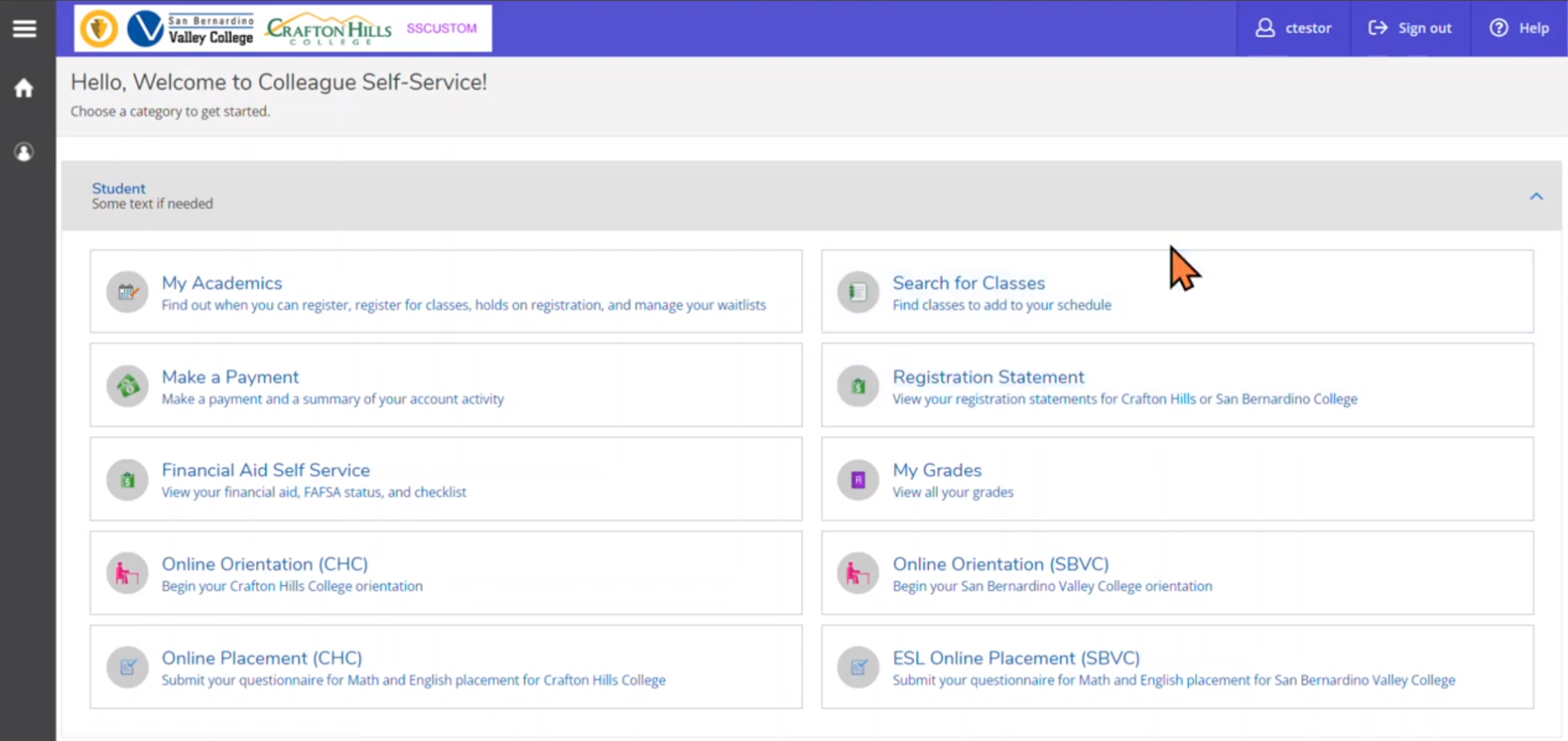Data Dictionary
Data Dictionary
*Indicates that the value is self-reported.
The annual period of instruction starting with the Summer semester and ending with the Spring semester.
Method used to calculate funding for class sections where:
- WK = weekly census
- WI = weekly independent study & work experience
- DC = daily census
- DI = daily independent study & work experiences
- PA = positive attendance
- EX = Exempt
Unduplicated count of students enrolled as of the last updated date.
The age range of a student based on the Start Date of the time period displayed.
The number of awards (either degrees or certificates) received by students during a specific timeframe.
SBVC offers 200+ degrees and certificates within six career and academic pathways.
- Arts, Communication, Design
- Business, Information Technology, Hospitality
- Health, Wellness, Athletics
- Manufacturing, Industry, Transportation
- Public Service, Culture, Society
- Science, Engineering, Math
Crafton Hills College
The official day for student headcount based on attendance.
Count of students enrolled as of census date.
Classification of Instructional Programs code for course (used in IPEDS reporting). It is a six digit code that identifies instructional program specialties.
Group who share an important date, e.g., date of birth, date of entry into college, date of acceptance into a program, etc.
A specific group of students established for tracking purposes.The delivery of course material through one of the following methods:
- Hybrid - Any course that has both a face-to-face component and an online component.
- In Person - Any course that meets face-to-face.
- Online Asynchronous - Any online course where the instruction and learning occur at different times.
- Online Hybrid (Asynch/Synch) - Any online course with both Asynchronous and Synchronous components.
- Online Synchronous - Any online course where the instruction and learning occur at the same time.
A student who indicated that their Educational Goal is one of:
- Bachelors Degree after Associates (A)
- Bachelors Degree w/o Associates (B)
- Associate Degree w/o Transfer (C)
According to the Chancellor’s Office, “disproportionate impact is a condition where some students’ access to key resources and supports and ultimately their academic success may be hampered by inequitable practices, policies, and approaches to student support.” (California Community College Chancellor’s Office, 2013)
To determine if a group is experiencing DI, we use the PPG-1 method.
Executive Information System
A pivot table presentation of data queried from the Datatel database. It was designed to be used by administrators, planners, and researchers.
Students select one of:
- Hispanic
- Non-Hispanic
Often confused with Race.
A first-generation student is one who reported one of the following:
- Highest level completed by both parents is High School Graduate or or below
- Highest level completed by one parent is High School Graduate or below, and the other parent is either Unknown or No Parent/Guardian
- Both parents are No Parent/Guardian
- July 1st to June 30th of the following year.
Full-time Equivalent Faculty
Refers to the load factor associated with each section assignment.
Full-Time Equivalency Student
The unit of measure based on attendance patterns used to state apportionment funds. FTES for most classes use the following formula:
Number of students × number of hours per week × 17.5 weeks ÷ 525
“Positive Attendance” sections, and courses with labs, are
calculated differently. Totaling all undergraduate credit hours awarded over a defined period and dividing that number by 15 is sometimes used to derive a rough estimate of FTES.Full-time Equivalent Faculty/Full-Time Equivalency Student
The productivity measure used for instruction where 17.5 is the norm for California Community Colleges.
- Full-time/part-time ratio compares the number of full-time FTEF to the number of part-time FTEF. Statewide goals are 75% full time, 25% part time with the decade. AB1725 requires progress toward reaching the goal of 75% full-time faculty FTEF.
The gender identity that the student specified on their application. The options available to students are Female, Male, Non-binary, Decline to state.
Note that Non-binary only become available as of May 2023.
A Grade on Record (GOR) is any grade that counts toward a student's GPA. These grades are A, B, C, D, F, W, NP, P, CR, and NC.
These are the only grades used to determine Success and Retention Rates.
A count of students where each student is counted only once.
For example, if 10 students are each taking 2 classes, then:
Headcount = 10
Seat Count = 20
Hispanic-Serving Institution
The Higher Education Act, 20 USCA Section 1101a defines a Hispanic-serving institution as an institution of higher education that (a) is an eligible institution; (b) at the time of application, has an enrollment of undergraduate full-time equivalent students that is at least 25 percent Hispanic students; and (c) provides assurances that not less than 50 percent of the institution’s Hispanic students are low-income individuals. Note: low income is defined as 150% of the poverty level as determined by the Bureau of the Census at https://www.census.gov/hhes/poverty.povdef.html.
The Integrated Postsecondary Education Data System (IPEDS) conducted by the National Center for Educational Statistics (NCES). IPEDS began in 1986 and involves annual institution-level data collections. All postsecondary institutions that have a program participation agreement with the Office of Postsecondary Education (OPE), U.S. Department of Education are required to report data using a web-based data collection system. IPEDS currently consists of the following components: Institutional Characteristics (IC); Completions (C); Employees by assigned positions (EAP); Fall Staff (S); Salaries (SA); Enrollment (EF); Graduation Rates (GRS); Finance (F); and Student Financial Aid (SFA). Failure to meet reporting deadlines can result in severe fines and penalties.
Maximum number of students ever enrolled in section, excluding those who dropped before section start date.
Minimum number of enrolled students section need to remain active (n = 20 if course has a prerequisite; n = 15, if course does not have prerequisite)
Management Information System
Data presentation protocol used by the State Chancellor’s office.
The percentage of students who continue enrollment from the Fall term to the following Spring term.
Often confused with Retention.
There are 9 main Races:
- Asian
- Black/African American
- Filipino
- Hispanic
- Native American/Alaskan Native
- Pacific Islander/Hawaiian Native
- Two or More Races
- Unknown/Unreported
- White
IPEDS requires that all students who reported Hispanic as their ethnicity are reported as Hispanic independent of any reported races. Those who do not identify as Hispanic but select two or more races are reported as 'Two or More Races'.
For example, the following student is reported as Hispanic.
Selected Ethnicity = Hispanic
Selected Races = Asian, Filipino, and Hispanic
- The 12 month year that corresponds to a fiscal year, July 1 to July 30. The reporting year assigned to a section is based on its ending date. For example, sections ending between 07/01/2000 and 06/30/2001 are assigned Reporting Year 2001.
The percentage of Grades on Record that were counted as completed at the end of the term (A, B, C, D, F, P, NP, CR, NC).
Student Accountability Model priority code for vocational/occupational courses, where
- A = apprenticeship
- B = advanced occupational
- C = clearly occupational
- D = possibly occupational
- E = non-occupational
San Bernardino Community College District
San Bernardino Valley College
- Maximum capacity of course (may be limited by contract and/or classroom size).
A count of students where each student may be counted more than once.
For example, if 10 students are each taking 2 classes, then:
Seat Count = 20
Headcount = 10
Unique section identification number.
Status of section as of warehouse date, where
- A = active
- C = cancelled
- P = pending
- H = hiatus
For all dashboards, only Active sections are counted.
Semester during which section offered, where FA = Fall, SM = Summer, and SP = Spring.
Students that may require special consideration and attention to ensure equal opportunity for success in an educational setting. These include:
- Disability
- First-Generation
- Foster Youth
- Veteran
Any program/department on campus dedicated to supporting students. Note that the data is pulled from the XSTM3 screen in Colleague, which is updated by each program at the ends of each semester. The Support Programs available on the dashboards are:
- California Adult Education Program
- CALWORKS
- Dedicated Engagement to Empowering Part-Timers (DEEP)
- Dual Enrollment (including CCAP)
- First Year Experience (FYE)
- Honors Program
- Middle College High School (MCHS)
- MESA
- Potential STEM Students
- Puente Project
- Sports (Athletes)
- STAR Program
- Umoja-Tumaini
- Valley Bound
The percentage of all passing Grades on Record (A, B, C, P, CR).
DATATEL name for the section reference number used in class schedule.
Year section is offered followed by semester.
Example: 2017SM, 2017FA, 2018SP are the terms in the Academic Year 2017-2018
The period of day in which the course starts.
- Morning: Course Starts Before 12pm
- Afternoon: Course Starts Between 12pm and 5pm
- Evening: Course Starts At 5pm or Later
- Online: Online Asynchronous Courses
Taxonomy of Programs (TOP) code indicates the subject matter of a course.
Weekly Student Contact Hours
The number of students in a class at census multiplied by the hours of student instruction conducted in that class in a week during a fall or spring term.
Weekly Student Contact Hours/Full-time Equivalent Faculty
The productivity measure used for instruction, where 525 is the norm for California Community Colleges.


